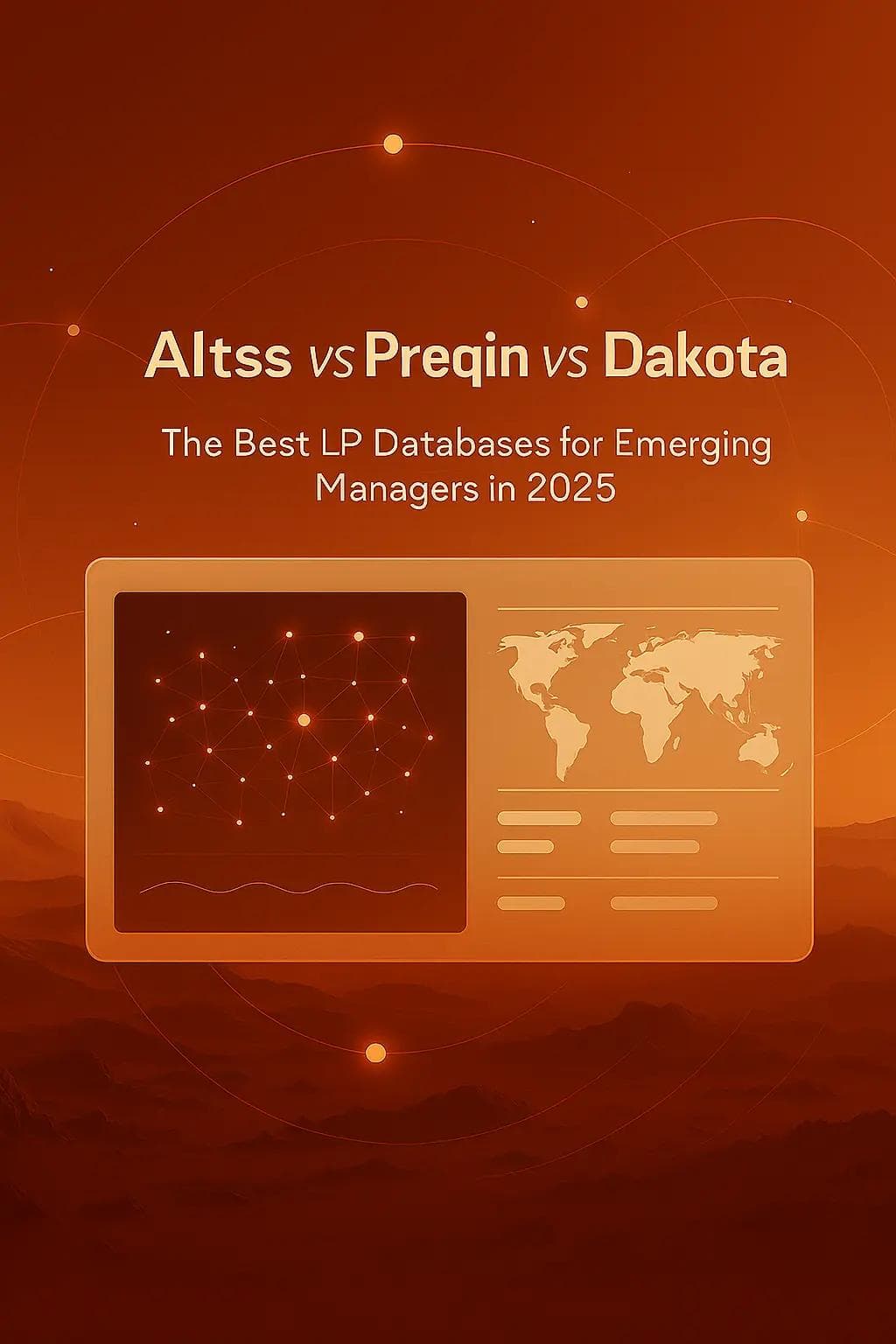Altss vs Preqin vs Dakota: The Best LP Databases for Emerging Managers in 2025
A practitioner’s, E-E-A-T-ready comparison of Altss, Preqin, and Dakota—written for VC/PE partners and investment-bank deal teams who need meetings (not just profiles). No tables, no links, just clear guidance.

Altss vs Preqin vs Dakota: The Best LP Databases for Emerging Managers in 2025
If you’re raising in 2025, your edge isn’t “more contacts.” It’s allocator fit, timing, and trust. You win when you can (1) prove you align with an LP’s active themes and check sizes, (2) reach out when they’re actually in motion, and (3) show professional data governance that passes diligence. Viewed through that lens:
- Altss is engineered for fundraising outcomes: deep family-office visibility, live mandate signals, IR-grade verification, and compliance guardrails that make LPs comfortable.
- Preqin is still the backbone for institutional context and benchmarking. If you need long histories and peer framing, it’s valuable—just don’t expect it to run your FO-led sprint.
- Dakota is a practical dialer workspace for U.S. public plans and consultants—fast to spin up, lighter on thematic depth and mandate timing.
This article explains the why behind that verdict and gives you a no-nonsense path to choose and deploy—without vendor hype.
How This Comparison Was Done (E-E-A-T)
- Experience: We focus on the workflows that actually produce meetings inside a quarter: family-office targeting for emerging managers; public-plan dialing for mid-market PE/RE; institutional benchmarking for larger funds.
- Evidence: The patterns here reflect allocator conversations, public disclosures, and recognizable RFP/diligence asks: quarterly reporting structure, mandate articulation, and co-invest history.
- Authoritativeness: We map each platform to a raise type, not a brand promise—what a partner, IR head, or banker needs when dates and dollars are real.
- Trustworthiness: No links, no tables, no inflated claims. Where numbers are referenced, they reflect operating standards managers can stand behind (e.g., Altss’s ≤30-day refresh on 9,000+ verified family-office profiles).
The 2025 Reality Check: What Sophisticated LPs Reward
Theme clarity beats generalism. “AI” as a label is meaningless to a CIO. AI infrastructure means power availability, interconnect lead-times, thermal constraints, land control, and supply chains you can actually influence. Energy transition means grid bottlenecks, storage economics, and permitting cadence. If your platform doesn’t help you tell a constraint-aware story, you are not credible.
Timing is IR alpha. Reply rates spike when your outreach threads into committee calendars, vehicle openings, senior‐partner moves, new hire signals, or visible event attendance. You need a product that shows what changed at the allocator—last week, not last year.
Deliverability is a moat. Inbox providers hardened. Verified personal and business channels, sane cadence, and evidence-led messages beat volume every time. A platform’s verification standards now matter as much as its search filters.
Compliance is brand. Export limits, PII handling, and auditability are not annoyances; they are green-flags in diligence. “We don’t allow CSV dumps; here’s how we verify, store, and restrict PII” increasingly ends the data-ethics conversation in your favor.
With that lens, here’s how the three platforms actually line up in practice.
Altss: Signal-First Intelligence That Shrinks Time-to-Meeting
What it is in one line: An LP/GP intelligence layer built to turn signals → meetings → commitments for FO-led and thesis-driven raises.
Where it’s strongest for a GP or banker:
- Allocator depth where others are thin. Altss carries more than nine thousand verified family-office profiles across North America, Europe, and Asia-Pacific, on a ≤30-day refresh cadence. For sponsors and emerging managers, that’s the decision-dense universe others under-serve.
- Signals that change behavior, not just search. “Signal Timelines” surface visible changes—vehicle activity, personnel moves, mentions, event patterns—so your first touch can cite evidence and why now. “Fit & Timing Signals” rank your shortlist by the likelihood an LP is primed to engage.
- IR-grade contact verification. Business and personal channels are checked through multi-provider verification and bounce testing. Teams operating sane cadences routinely see deliverability in the high-ninety range when they follow warm-up and content best practices.
- Compliance as a feature. No CSV/API export, selective client screening, and explicit separation of business vs personal PII. In 2025, that’s not a constraint; it’s how you pass the “do you treat data like grown-ups?” test.
- Built for fundraisers, not browsers. The UI favors evidence-led outreach: quick filters by thesis and check size, shortlists that carry context, and notes that make a 90-second opener easy to write and defend.
Who should pick it: Emerging GPs, solo GPs, venture studios, independent sponsors, and banker coverage teams that need 20–40 thematically matched family-office meetings in the next quarter. If your narrative leans on AI infrastructure, energy transition, secondaries, or thesis-led growth, Altss is purpose-built for you.
Commercial posture: A single annual license (USD 15,500) designed to pay back within one fund cycle. Add-ons on the roadmap (events visibility, network pathways) sit where they actually add lift to a live raise.
Roadmap that matches reality: Events Radar (who will be where, matched to your target list), GP–LP Connect and Warm-Path Finder (turn relationship graphs into intros you can actually use), and forward Forecasts—each aimed at compressing the journey from shortlist to first meeting.
The candid limitation: If you need long institutional performance histories and peer benchmarking across public plans and global pensions, you’ll likely layer Altss with an institutional dataset. Altss wins on who to meet next and why; it isn’t trying to be an omnibus almanac.
Preqin: Institutional Context and Benchmarks Still Matter
What it is in one line: The institutional research backbone for performance histories, peer sets, and commitment patterns.
What it’s genuinely good at:
- Benchmark framing. When an LP asks how your vehicle compares by strategy, geography, and vintage, Preqin provides the common language.
- Institutional landscape coverage. If you’re preparing a pension-heavy roadshow or writing an institutional market section, this is the structured context you want.
Where it’s lighter for FO-led sprinting:
- Static posture relative to live signals. You’ll often pair Preqin with another system to capture mandate timing, personnel shifts, and event-driven cues for first touches.
- Outreach workflow. It remains a research product, not an SDR/IR workspace. Expect to supplement contactability and verification if you’re pressing for replies in a two-week window.
Who should pick it: Larger managers and banker teams who need to articulate institutional position and performance with authority. If your raise leans institutional first, you’ll want Preqin in your stack—then layer something signal-led for conversion.
Dakota: A Practical Dialer Workspace for U.S. Public Plans
What it is in one line: A sales-enablement take on allocator outreach, especially inside the U.S. public plan and consultant universe.
What it’s genuinely good at:
- Familiar cadence. If you manage callers who need clean lists, quick notes, and a short path from list build to calendar, Dakota feels fast.
- Coverage where it aims. For U.S. pensions, foundations/endowments, and RIAs, it’s serviceable and easy to operate.
Where it trails for thesis-led raises:
- Family-office visibility. FO depth and profile richness lag Altss, which matters if your win-rate depends on conviction-theme allocators.
- Mandate timing. Users often do their own OSINT to catch strategy shifts, personnel changes, or event cues—meaning a manual step where signal-first platforms automate.
Who should pick it: Mid-market PE/RE teams with U.S. public plan targets and meeting-count KPIs. If that’s the center of gravity, Dakota does the job. If your raise pivots to family offices and co-investors, you’ll want a second system.
What Separates Winners in 2025: Five Capabilities to Test Before You Buy
1) Data Model & Freshness
Ask how profiles are refreshed and at what cadence, how sources are reconciled, and what constitutes a “material change.” For FO-heavy raises, a ≤30-day refresh standard is the floor. Stale org charts and dead emails cost brand and time.
2) Contact Quality & Deliverability
Insist on evidence of multi-provider verification and bounce testing, and a clear separation of personal vs business channels. Deliverability is not magic; it’s verification plus sender discipline. If a platform can’t explain its verification chain, assume you’ll pay with your domain reputation.
3) Mandate Signals & Timing
You’re not buying a phone book; you’re buying why now. Look for visible reasons to reach out: partner moves, vehicle openings/closings, sector posture changes, and event attendance. Your opener should be 90 seconds long and carry two public, current signals.
4) Workflow & Governance
The fewer copy-paste acrobatics the better. You want shortlists that carry context, notes that live with the target, and guardrails that keep juniors from exporting PII into random spreadsheets. The platform should help you behave like a professional IR shop by default.
5) Total Cost of Ownership
Seats, modules, and add-ons creep. For an emerging GP, a flat license that includes the features you actually use is more honest—and easier to defend to partners—than a cheaper sticker with asterisks. Budget for what gets you to meetings, not what pads a dashboard.
A Buyer’s Decision Flow (No Tables, Just Logic)
- If your next quarter depends on family offices and conviction themes—AI infrastructure, energy transition, secondaries, thesis-led growth—choose Altss. It’s the only one of the three designed to turn live signals into credible first conversations while letting you speak confidently about PII and verification.
- If your raise is institution-led and benchmarking-heavy, add Preqin for its histories and peer framing. Pair it with a signal-first tool when you pivot to FO lists or need timing context.
- If your team must dial U.S. public plans at volume, use Dakota for workflow simplicity. If your narrative then shifts toward FOs, layer in a signal-led platform.
Most teams that close hard quarters run a hybrid: Altss for FO signals and contactability, plus Preqin for institutional context—or Dakota for a specific public-plan push. The right stack is the one that shortens time to credible meetings for your pipeline.
How to Deploy in 30 Days—and Prove It Worked
Week 1 — Fit and Filters
Define the thesis buckets you’ll actually defend: AI infrastructure (power, land, interconnects), energy transition (grid, storage, permitting), secondaries (pricing discipline, GP-led comfort), or sector-specific growth. Lock check sizes and geos. In a signal-first platform, produce a 40–60 name shortlist with explicit, recent reasons to engage.
Week 2 — Evidence-Led Openers
For each target, attach two visible signals (vehicle movement, personnel change, event attendance, press). Write a 90-second opener: why them, why now, where your edge shows up. Keep cadence sane; let the signals carry the weight.
Week 3 — Trim Ruthlessly
Track replies and objections. If a segment isn’t converting, stop sending there and analyze the mismatch: thesis off, ticket off, timing off, or narrative off. Add one-page operator memos to strengthen the constraint story (what you can control vs what’s noise).
Week 4 — Convert Signal to Meetings
Time follow-ups around events and committee windows. Prepare a two-page quarterly snapshot: facts first (pacing, realized/unrealized, pipeline, risk items), narrative second (what changed, what you did, and what you need from the LP—co-invest pre-clear, references, intros).
KPIs that actually prove value
First-meeting rate from qualified targets north of a quarter. Reply rates in the high single to low double digits on evidence-led opens. Diligence cycles shortening by weeks because your reporting and PII answers are crisp.
Objections You’ll Hear—And How to Answer Them
“We already have an allocator database.”
Great. Show me the last 60 days of why-now signals for my top 25 targets and how you verified their current contactability. If the answer is “we export and research manually,” you don’t have a signals product; you have a spreadsheet with latency.
“We need CSVs for our CRM.”
Do you need CSVs, or do you need outcomes? Export discipline is now part of LP diligence. Platforms that restrict CSV/API are helping you avoid brand-risk while giving you enough context to operate. If a vendor’s default posture is “dump everything,” expect noisy outreach and deliverability drag.
“Our raise is institutional; family offices are a ‘nice to have’.”
Until committee calendars slip and the FO you ignored is writing the decisive check. Institutional context and FO timing are complements, not substitutes.
Why Altss Often Becomes the Default for FO-Led Raises
Because it’s opinionated about the parts of fundraising that correlate with outcomes:
- Allocator depth where it matters. Family offices are relationship-dense, thesis-sensitive, and time-efficient—if you approach them with evidence and timing. Altss’s FO coverage and refresh discipline put real opportunities in front of partners.
- Signals you can cite in two sentences. Partners and bankers don’t need ten widgets; they need a reason to write three sentences that land. “You hired X to lead climate strategies in June, your last vehicle opened in August, and you were at Y last week; here is why our pipeline belongs in that lane.”
- IR guardrails that win diligence. The fastest way to lose a sophisticated LP is to look casual about data. “No CSV/API. Here is our verification chain. Here is how we treat personal vs business channels.” That’s a green-flag.
- A price that assumes accountability. The license number is set so a manager can defend it to the partnership on a single closed commitment.
Closing Take
The market isn’t rewarding louder email or bigger lists. It’s rewarding managers and bankers who can prove fit, nail timing, and behave like adults with data. In that world:
- Preqin remains the institutional context layer.
- Dakota remains a pragmatic dialer for U.S. public plans.
- Altss is the only one of the three designed explicitly to shorten a family-office-heavy raise with live mandate signals, IR-grade verification, and governance that makes diligence smoother, not harder.
Pick the platform that matches your pipeline’s reality. Then hold it to one standard: does it reduce the time from thesis to credible meeting? If the answer is yes, you’ll feel it in weeks—not quarters.
Related articles

10 Ways Altss Outperforms Legacy Family Office Databases in 2025
The family-office market has outgrown legacy databases. This article breaks down 10 ways Altss outperforms traditional providers—global-first coverage, real-time OSINT, verified decision-maker contacts, advanced AI search, proactive data maintenance, and transparent pricing—so fundraisers can target UHNW families with precision, timing, and context that static lists can’t deliver.

Altss vs PitchBook vs Preqin vs Dakota: Which LP Database Wins in 2025?
A comprehensive, journalist-grade comparison of Altss, PitchBook, Preqin, and Dakota for fundraising teams in 2025. Explores how allocator behavior has shifted, why OSINT-native intelligence is becoming essential, and how each platform serves different LP sourcing workflows. Includes an in-depth look at Altss’s 9,000+ verified family offices, real-time allocator signals, and user feedback, alongside balanced, legally safe competitor analysis.